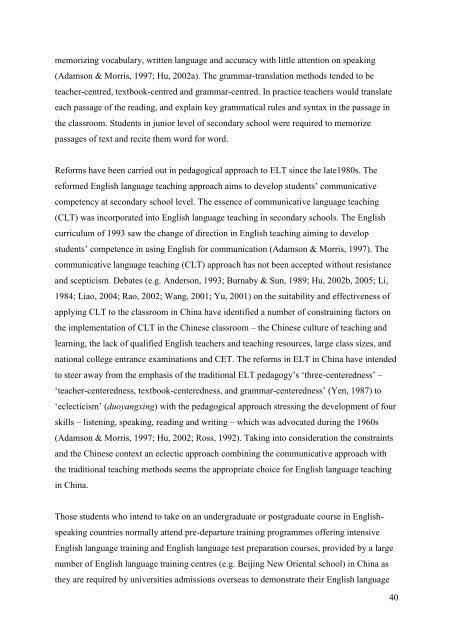The challenge of academic writing for Chinese students within ...
The challenge of academic writing for Chinese students within ...
The challenge of academic writing for Chinese students within ...
Create successful ePaper yourself
Turn your PDF publications into a flip-book with our unique Google optimized e-Paper software.
memorizing vocabulary, written language and accuracy with little attention on speaking<br />
(Adamson & Morris, 1997; Hu, 2002a). <strong>The</strong> grammar-translation methods tended to be<br />
teacher-centred, textbook-centred and grammar-centred. In practice teachers would translate<br />
each passage <strong>of</strong> the reading, and explain key grammatical rules and syntax in the passage in<br />
the classroom. Students in junior level <strong>of</strong> secondary school were required to memorize<br />
passages <strong>of</strong> text and recite them word <strong>for</strong> word.<br />
Re<strong>for</strong>ms have been carried out in pedagogical approach to ELT since the late1980s. <strong>The</strong><br />
re<strong>for</strong>med English language teaching approach aims to develop <strong>students</strong>‘ communicative<br />
competency at secondary school level. <strong>The</strong> essence <strong>of</strong> communicative language teaching<br />
(CLT) was incorporated into English language teaching in secondary schools. <strong>The</strong> English<br />
curriculum <strong>of</strong> 1993 saw the change <strong>of</strong> direction in English teaching aiming to develop<br />
<strong>students</strong>‘ competence in using English <strong>for</strong> communication (Adamson & Morris, 1997). <strong>The</strong><br />
communicative language teaching (CLT) approach has not been accepted without resistance<br />
and scepticism. Debates (e.g. Anderson, 1993; Burnaby & Sun, 1989; Hu, 2002b, 2005; Li,<br />
1984; Liao, 2004; Rao, 2002; Wang, 2001; Yu, 2001) on the suitability and effectiveness <strong>of</strong><br />
applying CLT to the classroom in China have identified a number <strong>of</strong> constraining factors on<br />
the implementation <strong>of</strong> CLT in the <strong>Chinese</strong> classroom – the <strong>Chinese</strong> culture <strong>of</strong> teaching and<br />
learning, the lack <strong>of</strong> qualified English teachers and teaching resources, large class sizes, and<br />
national college entrance examinations and CET. <strong>The</strong> re<strong>for</strong>ms in ELT in China have intended<br />
to steer away from the emphasis <strong>of</strong> the traditional ELT pedagogy‘s ‗three-centeredness‘ –<br />
‗teacher-centeredness, textbook-centeredness, and grammar-centeredness‘ (Yen, 1987) to<br />
‗eclecticism‘ (duoyangxing) with the pedagogical approach stressing the development <strong>of</strong> four<br />
skills – listening, speaking, reading and <strong>writing</strong> – which was advocated during the 1960s<br />
(Adamson & Morris, 1997; Hu, 2002; Ross, 1992). Taking into consideration the constraints<br />
and the <strong>Chinese</strong> context an eclectic approach combining the communicative approach with<br />
the traditional teaching methods seems the appropriate choice <strong>for</strong> English language teaching<br />
in China.<br />
Those <strong>students</strong> who intend to take on an undergraduate or postgraduate course in Englishspeaking<br />
countries normally attend pre-departure training programmes <strong>of</strong>fering intensive<br />
English language training and English language test preparation courses, provided by a large<br />
number <strong>of</strong> English language training centres (e.g. Beijing New Oriental school) in China as<br />
they are required by universities admissions overseas to demonstrate their English language<br />
40


